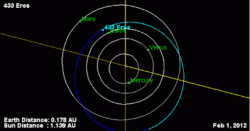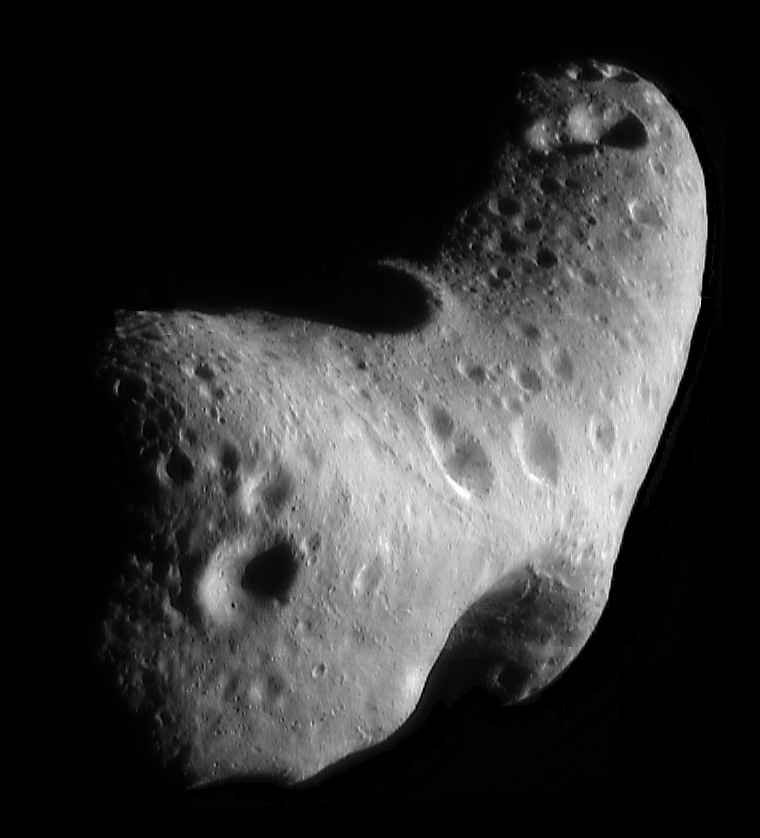[/caption]
On Tuesday, January 31, asteroid 433 Eros will come closer to Earth than it has in 37 years, traveling across the night sky in the constellations Leo, Sextans and Hydra. At its closest pass of 16.6 million miles (26.7 million km) the relatively bright 21-mile (34-km) -wide asteroid will be visible with even modest backyard telescopes, approaching magnitude 8, possibly even 7. It hasn’t come this close since 1975, and won’t do so again until 2056!
433 Eros is an S-type asteroid, signifying a composition of magnesium silicates and iron. S-types make up about 17 percent of known asteroids and are some of the brightest, with albedos (reflectivity) in the range of 0.10 – 0.22. S-type asteroids are most common in the inner asteroid belt and, as in the case of Eros, can even pass within the orbit of Mars.
Occasionally Eros’ orbit brings it close enough to Earth that it can be spotted with amateur telescopes. 2012 will be one of those times.
Eros was discovered on August 13, 1898, by astronomers Carl Gustav Witt in Berlin and Auguste Charlois in Nice. When Eros’ orbit was calculated it was seen to be an elongated oval that brought it within the orbit of Mars. This allowed for good observations of the bright asteroid, and eventually led to more accurate estimates of the distance from Earth to the Sun.
In February 2000 NASA’s NEAR Shoemaker spacecraft approached Eros, established orbit and made a soft landing on its surface, the first mission ever to do so. While in orbit NEAR took over 160,000 images of Eros’ surface, identifying over 100,000 craters, a million house-sized boulders (give or take a few) and helped researchers conclude that the cashew-shaped Eros is a solid object rather than a “rubble pile” held together by gravity.
View NEAR images of Eros’ surface.
Studying pristine objects like Eros gives insight into the earliest days of our solar system, and also allows scientists to better understand asteroid compositions… which is invaluable information when deciding how best to avoid any potential future impacts.

Although Eros will be making a “close” approach to Earth on Jan. 31/Feb. 1, there is no danger of a collision. It will still remain at a very respectable distance of about 16.6 million miles (26.7 million km), or 0.178 AU. This is over 80 times the distance of the much smaller 2005 YU55, which safely passed within a lunar orbit radius on November 8, 2011.
If you do want to try viewing 433 Eros as it passes, you can find a diagram charting its path from Sky and Telescope here. According to the Sydney Observatory’s website “the coordinates on 31 January (from the BAA 2012 Handbook) are 10 hours 33 minutes 19.0 seconds RA and -4° 48’ 23” declination. On 10 February the RA is 10 hours 20 minutes 27.6 seconds and the declination is -14° 38’ 49 seconds.”
Also there’s an updated chart on Heavens Above showing Eros’ current position.
Eros should remain visible up until Feb. 10.
Thanks to Skyscrapers, Inc., for a report on 433 Eros by Glenn Chaple. Skyscrapers, Inc. is an amateur astronomy society in Rhode Island that operates the Seagrave Observatory, whose centerpiece is a beautiful 8 1/4″ Alvan Clark telescope built in 1878. I saw Halley’s Comet through that telescope in 1986 and have been hooked on astronomy ever since.


What will it look like at certain magnifications? Will it simply look like a small star in an amateur telescope?
Basically, yes.
I did a quick calculation. Given that the asteroid is 21 miles across, at a distance of 16.6 million miles, from earth it will have an apparent size of 0.2592 arc seconds.
Personally, with my telescope gear and fairly basic knowledge of astrophotography, I get an image resolution of 0.95 arc seconds per pixel.
I’m not one of those awesome astrophoto guys that gets details on Jupiter’s moons, or that gets shots of Mars from their backyard that rival what we had in school textbooks in the early 1980’s, but I suspect that even if I was it would be very difficult to resolve such a small object to even show it’s shape, especially since it will be moving fast across the sky (relatively).
Amateurs! Please prove me wrong!
So it’s a solid object. How could something with so little gravity come together on its own as solid? And if it did form on its own, wouldn’t it be round or at least roundish? Is there an idea that it is formerly part of a larger object? If you do see it in a telescope, can you tell that it’s rotating because of its lack of sphereicality?
Not the expert by a long shot but I would suspect that the majority of these objects were molten tumbling bits of material following violent collisions while the solar system was forming thus the odd but smooth shapes. Just like molten volcanic material after cooling.
“If you do see it in a telescope, can you tell that it’s rotating because of its lack of sphereicality?”
Eros will appear to vary slightly in brightness as it rotates: http://www.solarviews.com/browse/eros/eros4.gif
Just out of curiosity; if such an asteroid around the size of Eros (21miles), composition (magnesium silicates and iron sounds pretty solid to me) and had a trajectory that took into a full impact with Earth, what sort of damage would we be looking at?
Try this calculator program: Impact Earth!
P.S. Here’s the original one: Earth Impact Effects Program.
In short: Bye bye life on Earth.
The asteroid that killed off the dinosaurs (and many other life forms of the day) some 65 million years ago was ~10km across (6.2 miles), so imagine something much larger, like Eros. Ain’t a pretty thought!
—JL Galache
Minor Planet Center
@Ken Lord
You don’t need a telescope able to resolve details smaller than 0.2592 arcseconds because you don’t need to see details with that size. But you’ll see a small “moving star” wit a magnitude of 8 or 7 (which is quite big for an asteroid) and you could see this even with a good binocular. You shouldn’t confuse the luminosity with details.